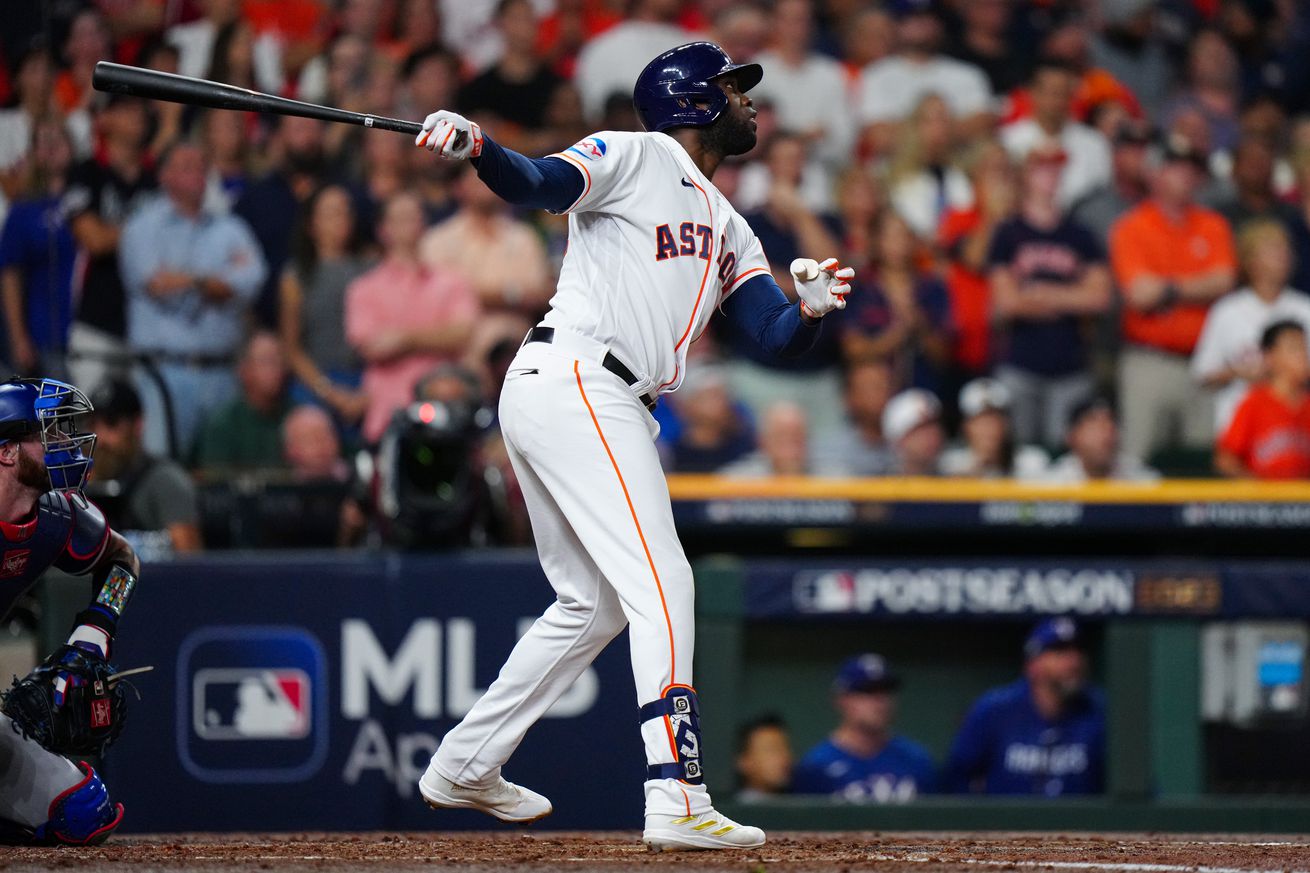
Let’s dive deeper into the Astros’ plan to hit the left-handed slugger higher in the batting order in 2024.
Other than signing Josh Hader, the Astros had a relatively uneventful offseason. Dana Brown did scour the waiver wire and picked up a couple of interesting arms for the bullpen. Right-handed reliever Dylan Coleman was brought in via trade with the Royals. Victor Caratini was signed to be the backup catcher to Yainer Díaz. Sure, Hader by himself is a large enough acquisition to change the complexion of an offseason. Still, the organization wasn’t exactly in a position where it had to make a big move. If anything else, Joe Espada being named the manager for 2024 might be where the most improvement occurs.
Frankly, I peg a large amount of improvement this year to come from within the existing roster, primarily with playing time increases for Díaz and Chas McCormick along with a bit of additional effectiveness from the pitching staff. In the cases of Díaz and McCormick, their playing time was generally up to Dusty Baker, who leaned heavily on established veterans such as Martín Maldonado, and, when available, Michael Brantley. It was a source of consternation among fans and presumably within the organization to some degree, at least based on Brown’s comments last season about Díaz’s playing time earlier in the season. But with Espada now in charge, he will utilize some of the younger players more frequently than his predecessor. That’s worth something by itself.
Of course, the Astros have historically been better than average about picking up value on the margins. For example, the front office targeted various pitchers already on the fringes of other clubs, starting with Bennett Sousa in-season last year. The hope is that some of those arms, even if only one or two, will translate into viable major leaguers. For a club with a positive reputation surrounding its pitching development, those are the transactions that I love to see. With Espada now in charge as manager, I have a feeling that we’ll see the return of that approach with how he utilizes the roster, including, but not limited to, lineup construction.
The public understanding of lineup construction has advanced in recent history, thanks primarily to The Book by Tom Tango, Mitchel Lichtman, and Andy Dolphin along with subsequent analysis from other various writers. It is generally accepted now, at least among the analytical crowd, that a team’s best three hitters ought to hit first, second, and fourth in a lineup. While the additional runs gained with a more optimized batting order are relatively minor — “10 to 15 runs over 162 games”, according to The Book’s initial analysis — it remains an advantage to pursue as runs count, no matter how seemingly little in a cumulative amount. In that light, Espada being more open to analytical suggestions could help provide a bit more of an advantage during a 162-game season.
So, why do I bring this point up? Mostly due to Espada mentioning his plan to hit Yordan Alvarez second in his lineup, with Jose Altuve, Alex Bregman, and Kyle Tucker rounding out the top four spots.
Joe Espada said his plan right now is to bat Yordan Alvarez second. The ideal top four of his lineup is Jose Altuve, Alvarez, Alex Bregman and Kyle Tucker.
— Chandler Rome (@Chandler_Rome) February 25, 2024
The Astros’ best hitter since 2021 by wRC+, Alvarez hitting second would be an interesting departure for the organization, at least when compared to Baker’s tenure. Dating back to 2021 in games started, below is where in the order Baker placed Alvarez.
Hitting 2nd: 1
Hitting 3rd: 186
Hitting 4th: 173
Hitting 5th: 19
Hitting 6th: 3
Of those 382 games started with Baker as his manager, Alvarez hit third nearly half of the time — roughly 49% — followed by hitting fourth about 45% of the time. Espada’s plan to hit Alvarez second represents a departure from how Baker preferred to utilize the left-handed slugger. Ironically, Alvarez was more appropriately utilized for hitting fourth than third in the order, primarily due to the number of times the latter comes to the plate with no runners on and two outs. While hitting fourth did cost Alvarez some plate appearances, it better optimized his impact as run values for the fourth hitter in the order are historically higher than hitting third.
By run values according to The Book, the plan to hit Alvarez second rather than fourth is a curious one. For one, the cleanup hitter has demonstrated a higher run value in all hit categories (singles, doubles, triples, and home runs). I do understand the allure of hitting Alvarez fourth in this regard considering his overall hit tool and in-game power as that spot generally holds more importance. However, the second hitter does historically generate a bit more value in regards to walks and hit-by-pitch. Plus, dating back to 2021, Alvarez has the highest on-base percentage on the Astros (.385) by a fairly large margin. Only Altuve and Bregman have a .360 or higher on-base percentage over the past three seasons for Houston hitters.
I believe Espada is willing to trade a bit of quality in Alvarez’s plate appearances for more quantity. But any trade-off between hitting second or fourth is quite small. And it makes sense as to why Espada would choose to hit Alvarez second and let Bregman hit third with Tucker following up fourth in the order mainly due to the difference in on-base percentage. After all, the number two hitter in today’s context is known for a higher on-base percentage, which certainly fits Alvarez’s profile. Ultimately, the decision to hit Alvarez second is proof that Espada hopes to optimize every possible angle he can as manager. For as much good as Baker did in other areas, this kind of development is a breath of fresh air from the club’s manager.